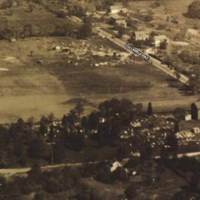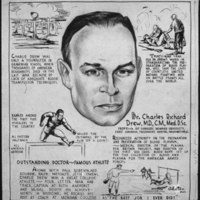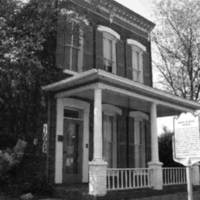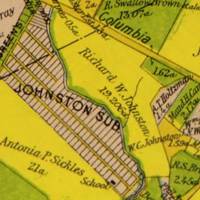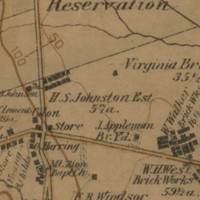Browse Items (7 items total)
This African American fraternal organization was founded in Arlington's Freedman'c Village community in 1870. It served many needs of the newly established and growing black community – hosting social functions, serving as a meeting ground for political functions, serving as a credit union, helping to establish internal community leadership, and supporting black churches and schools. In 1884 the Odd Fellows purchased land in the African American, middle class, Johnson's Hill community to construct the Odd Fellows Steven's Lodge No. 1453. The institutions remained a central part of Arlington's civic-minded African American community through the twentieth century. The Hall was destroyed by fire in 1965.
Collection: Community Institutions
Charles Drew was an African American surgeon and scientist whose pioneering work with blood plasma and transfusions saved countless lives during World War II. He ultimately left military service after the US Government attempted to segregate blood donations without any scientific need for such a policy. Drew served as a Professor at Howard University, the chief surgeon at Freedmen's Hospital, and became the first African American examiner for the American Board of Surgery. He died in a car accident in 1950 at the age of 45, leaving behind his wife Minnie and four children.
Collection: Civil Rights
Harry W. Gray was born into slavery at Arlington House plantation to parents Thornton and Selina Gray. Following the war Gray worked as a bricklayer before transitioning into work for the federal government, where he served first as a fireman and later an Assistant Messenger for the Department of the Interior.
With his skills in masonry, Gray built a large Italianate-style row home in the Johnson's Hill community in 1881. This home mimicked the style of houses then seen in Washington's African American Foggy Bottom neighborhood. Gray and his wife Martha raised four children in their home in Johnson's Hill. The Gray House is on the National Register of Historic Places.
With his skills in masonry, Gray built a large Italianate-style row home in the Johnson's Hill community in 1881. This home mimicked the style of houses then seen in Washington's African American Foggy Bottom neighborhood. Gray and his wife Martha raised four children in their home in Johnson's Hill. The Gray House is on the National Register of Historic Places.
Collection: Neighborhoods
The Gray House is an Italianate-style row home built by African American Harry W. Gray in the Johnson's Hill community of Arlington in 1882. The two-story, three-bay wide, red brick home mimicked the style of houses in Washington, D.C.'s Foggy Bottom neighborhood. With the use of this style, similar to those homes created by middle class African Americans in the nearby city, Gray illuminates his visions for what makes an area a good place to live and his aspirations for himself and his family in freedom.
Gray was born into slavery. During his time in enslavement he became a skilled mason and brick worker. He used these skills to build his home. After the Civil War Gray transitioned into work as a public servant with the Department of the Interior. Gray lived in the home in Johnson's Hill with his wife Martha, their four children, and two live-in servants.
The home was put on the National Register of Historic Places in 2003.
Gray was born into slavery. During his time in enslavement he became a skilled mason and brick worker. He used these skills to build his home. After the Civil War Gray transitioned into work as a public servant with the Department of the Interior. Gray lived in the home in Johnson's Hill with his wife Martha, their four children, and two live-in servants.
The home was put on the National Register of Historic Places in 2003.
Collection: Neighborhoods
The Johnson's Hill community was founded in 1880 when the white Johnston family began selling lots to African Americans leaving Freedman's Village. Early settlers included Harrison Green, Emmanus Jackson, and Harry W. Gray. These men were leaders in the African American community, helping to found the important United Order of Odd Fellows fraternal organization in the neighborhood.
The community is located on a hill along Columbia Pike, near both Arlington National Cemetery and Fort Myer. Today the area is known as Arlington View.
The community is located on a hill along Columbia Pike, near both Arlington National Cemetery and Fort Myer. Today the area is known as Arlington View.
Collection: Neighborhoods
In 1913 the Navy erected three huge radio towers at the intersection of Columbia Pike and Courthouse Road, between the two African American communities of Johnson's Hill and Butler-Holmes. These radio towers, called the “three sisters,” were marvels of modern communications technology and engineering in their time. They were the tallest man-made structures in the world upon their completion in 1913, towering over local pillar the Washington Monument. In 1915 they transmitted the first trans-Atlantic voice communication to the Eiffel Tower.
The towers were removed in 1941 because they obstructed flight-paths for the newly constructed Washington National Airport.
The towers were removed in 1941 because they obstructed flight-paths for the newly constructed Washington National Airport.
Collection: Neighborhoods
Johnson's Hill, today known as Arlington View, is an African American community located along Columbia Pike which first began ca. 1880. Here a tollgate was created at the intersection of Columbia Pike and the Georgetown-Alexandria Pike (today South Arlington Ridge Road). A small village center with houses, two stores, a post office, and a blacksmith shop formed around this tollgate, helping to expand and strengthen this African American community.
Collection: Neighborhoods
